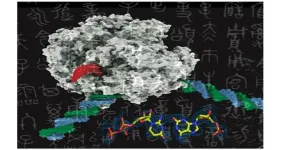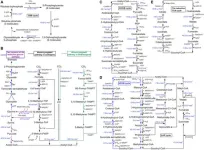(Press-News.org) Do you celebrate your birthday in the same month as your mum? If so, you are not alone. The phenomenon occurs more commonly than expected – a new study of millions of families has revealed.
Siblings also tend to share month of birth with each other, as do children and fathers, the analysis of 12 years’ worth of data shows, whilst parents are also born in the same month as one another more often than would be predicted.
Previous research has found that women’s season of birth somehow influences that of their children. But this research, published today in the peer-reviewed journal Population Studies, is the first to show that women are more likely to have children in the same month as their own birth.
The researchers from Spain and the US analyzed official data on more than 10 million births. They looked all births in Spain from 1980 to 1983 and from 2016 to 2019 and all births in France from 2000 to 2003 and from 2010 to 2013.
The records provided the child’s month of birth, as well as those of their parents and the sibling that was closest to them in age.
Births in a particular country tend to follow a pattern, with more babies being born at certain times of the year than at others. This is known in academic literature as birth seasonality.
But when the researchers divided the birth data into groups based on the month of birth of the mothers, the births didn’t follow the expected pattern.
Instead, there was a spike in January births among the mothers who were born in January, a spike in February babies in the mothers who were born in February and so on.
Overall, there were 4.6% more births in which mother and child shared the same birth month than would be expected.
This was true for both countries and all four time periods studied.
It was also the case for siblings (there were 12.1% more births than expected in which adjacent siblings had the same month of birth), parents with the same month of birth (4.4% more births) and when a child had the same birth month as their father (2% more births).
A second, less detailed, analysis of all the births in Spain from 1980 to 2019 and all births in France from 2000 to 2019, confirmed the result.
The phenomenon likely has its roots in relatives sharing socio-demographic characteristics: people of similar backgrounds are known to pair up and to be more likely to give birth at certain times of the year, say researchers Dr. Adela Recio Alcaide, of the University of Alcalá in Spain, and Professor Luisa N. Borrell, of the City University of New York in the United States.
In Spain, for example, a woman with a higher education is more likely to give birth in the spring than woman without a higher education. If she has a daughter, in addition to being more likely to be born in the spring, this daughter may be more likely to have higher education, since her mother has it. And thus, when this daughter has children, she will be more likely to have them in the spring too.
That is, this daughter will be more likely to have children in the same season in which she was born because she has kept her family sociodemographic characteristics – specifically the higher education– which make her more likely to give birth at a given time – spring – and, as a result, the season – and even month – of birth is passed between the generations.
Factors that can affect the biology of fertility, such as availability of food and exposure to sunlight, can also vary according to a person’s background.
“What could cause the higher probabilities of family members being born in the same season? The potential explanations seem to be both social and biological,” states Dr. Adela Recio Alcaide, an epidemiologist at the University of Alcala.
“The excess of children with a father and mother born in the same month seems to be due to social or behavioral causes prior to conception that relate to the choice of a partner born in the same month, as we have observed this excess with marriage statistics, with spouses being more likely to mate with someone from the same month.”
“This,” adds co-author Professor Luisa Borrell, from The City University of New York, “may not be surprising considering things such as partnerships tend to be formed by people with similar socio-demographic characteristics”.
“Moreover, biological factors that are known to affect birth seasonality—such as photoperiod exposure, temperature, humidity, and availability of food—also depend on socio-demographic characteristics, since different social groups are exposed to these biological factors to varying degrees,” Professor Borrell, a social epidemiologist at the City University’s Department of Epidemiology & Biostatistics, Graduate School of Public Health & Health Policy, says.
The study’s strengths include the large number of births included in the analysis and the inclusion of data from different decades and different countries. However, one limitation is that the analysis assumes an “independence of outcomes but that might not be the case and, therefore, dependence of the outcomes within families may have affected findings”. To adjust for this, the team repeated their analyses to account for dependency of outcomes within families and the results were very similar to those presented.
While this is a novel finding, further research is needed to confirm and deepen the results and their implications.
Concluding, the authors outline the importance that the link between family characteristics and birth month is considered in any future research into how a child’s month of birth affects their health, educational and other outcomes.
END
Mothers and children have their birthday in the same month more often than you’d think – and here’s why
Study of more than ten million births finds shared birth months are statistically common
2023-12-14
ELSE PRESS RELEASES FROM THIS DATE:
Bats declined as Britain felled trees for colonial shipbuilding
2023-12-14
Bat numbers declined as Britain’s trees were felled for shipbuilding in the early colonial period, new research shows.
The study, by the University of Exeter and the Bat Conservation Trust (BCT), found Britain’s Western barbastelle bat populations have dropped by 99% over several hundred years.
Animals’ DNA can be analysed to discover a “signature” of the past, including periods when populations declined, leading to more inbreeding and less genetic diversity.
Scientists used this method to discover the historic decline ...
Guest pre-intercalation: an effective strategy to boost multivalent ion storage
2023-12-14
Due to the merits of low cost, low installation requirements, and high-level safety, aqueous rechargeable batteries (ARBs) offer an ideal option for dealing with future energy-demand pressure. Traditional aqueous batteries are mostly concentrated on mono-valent metal-ion, such as Li+, Na+, and K+. Compared to mono-valent carriers, multivalent cations have the capability to transfer more than one electron, and thereby to potentially provide better energy storage. To date, aqueous multivalent ion batteries based on Zn2+ have received a lot of attention. However, the investigations on aqueous ...
Unravelling the association between neonatal proteins and adult health
2023-12-14
Research led by Professor John McGrath from the University of Queensland found that the concentration of the C4 protein, an important part of the immune system, was not associated with risk of mental disorders.
However, the research also showed that a higher concentration of the C3 protein reduces the risk of schizophrenia in women, and studies based on the genetic correlates of C4 found strong links with several autoimmune disorders.
Professor John McGrath from UQ’s Queensland Brain Institute said his colleagues at Aarhus University in Denmark looked at ...
Gut bacteria of malnourished children benefit from key elements in therapeutic food
2023-12-14
A clinical trial reported in 2021 and conducted by a team of researchers from Washington University School of Medicine in St. Louis and the International Centre for Diarrhoeal Disease Research in Dhaka, Bangladesh, showed that a newly designed therapeutic food aimed at repairing malnourished children’s underdeveloped gut microbiomes was superior to a widely used standard therapeutic food.
Now, another study from the same research team at Washington University School of Medicine has identified key, naturally occurring biochemical components of this new therapeutic food and the important bacterial strains that process these ...
Gayle Benson makes historic donation for new home for Ochsner Children’s Hospital
2023-12-14
NEW ORLEANS, La. – Ochsner Health announces plans for The Gayle and Tom Benson Ochsner Children’s Hospital, made possible through a transformational gift from Mrs. Gayle Benson.
“We are proud to unveil much-anticipated plans for a new home for Louisiana’s No. 1 ranked children’s hospital,” said Pete November, CEO, Ochsner Health. “Ochsner is deeply grateful for Mrs. Benson and her unparalleled act of generosity, which will significantly impact the lives of countless families throughout Louisiana and the Gulf South. This facility will enable us to care for more children, retain and attract top pediatric physicians ...
Enzymes can’t tell artificial DNA from the real thing
2023-12-14
The genetic alphabet contains just four letters, referring to the four nucleotides, the biochemical building blocks that comprise all DNA. Scientists have long wondered whether it’s possible to add more letters to this alphabet by creating brand-new nucleotides in the lab, but the utility of this innovation depends on whether or not cells can actually recognize and use artificial nucleotides to make proteins.
Now, researchers at Skaggs School of Pharmacy and Pharmaceutical Sciences at the University of California San Diego have ...
Decline in smoking in England has stalled since pandemic
2023-12-14
A decades-long decline in smoking prevalence in England has nearly ground to a halt since the start of the pandemic, according to a new study led by UCL researchers.
The study, funded by Cancer Research UK and published in the journal BMC Medicine, looked at survey responses from 101,960 adults between June 2017 and August 2022.
Before the Covid-19 pandemic, from June 2017 to February 2020, smoking prevalence fell by 5.2% a year, but this rate of decline slowed to 0.3% during the pandemic (from April 2020 to August 2022), the study ...
3G microbial cell factories: achieving sustainable goals with engineered microorganisms
2023-12-14
Fossil fuels are at the heart of most human activities, contributing to the increase in greenhouse gas emissions and the ever-rising atmospheric carbon dioxide (CO2) levels. CO2 levels are projected to increase exponentially in future, resulting in severe environmental and ecological impacts. A beacon of hope amidst this chaos are eco-friendly alternatives to fossil fuels.
Green energy sources can be developed using advanced biotechnological techniques. One such intervention is the use of biorefineries or microbial cell factories, that convert biomass (organic matter like plants and solid waste) into energy and valuable by-products. The first (1G) ...
Using deep learning to identify teens most in need of mental health support
2023-12-14
The personal yet global struggle with mental health may be more visible now than ever before. Yet many people still find it difficult to access the support they need. In Japan, suicide is sadly the leading cause of death for young people. Researchers, including from the University of Tokyo, have carried out a six-year study to better understand the myriad of factors which can impact adolescent mental health. After surveying 2,344 adolescents and their caregivers, and using computer-based deep learning to process the results, they were able to identify five categories which the young people could be grouped into. Nearly 40% of those involved were ...
The Lancet Psychiatry: Mental health care and research must directly confront systemic racism to improve the health and lives of Black Americans
2023-12-14
Improving the mental health and wellness of Black Americans requires acknowledging and confronting systemic racism underlying the US political, social, and healthcare systems that create and maintain racial inequality in every aspect of life for Black people in the USA.
The new Series of three papers on Black mental health in the USA, plus an essay from Black Americans with lived experience, published inThe Lancet Psychiatry journal, outlines the overwhelming evidence for the role racism plays in producing, maintaining, and amplifying mental health disparities for Black Americans. Against this background, the authors call for a comprehensive analysis of the conditions and systems in ...
LAST 30 PRESS RELEASES:
Automatic label checking: The missing step in making reliable medical AI
Low daily alcohol intake linked to 50% heightened mouth cancer risk in India
American Meteorological Society announces Rick Spinrad as 2026 President-Elect
Biomass-based carbon capture spotlighted in newly released global climate webinar recording
Illuminating invisible nano pollutants: advanced bioimaging tracks the full journey of emerging nanoscale contaminants in living systems
How does age affect recovery from spinal cord injury?
Novel AI tool offers prognosis for patients with head and neck cancer
Fathers’ microplastic exposure tied to their children’s metabolic problems
Research validates laboratory model for studying high-grade serous ovarian cancer
SIR 2026 delivers transformative breakthroughs in minimally invasive medicine to improve patient care
Stem Cell Reports most downloaded papers of 2025 highlight the breadth and impact of stem cell research
Oxford-led study estimates NHS spends around 3% of its primary and secondary care budget on the health impacts of heat and cold in England
A researcher’s long quest leads to a smart composite breakthrough
Urban wild bees act as “microbial sensors” of city health.
New study finds where you live affects recovery after a hip fracture
Forecasting the impact of fully automated vehicle adoption on US road traffic injuries
Alcohol-related hospitalizations from 2016 to 2022
Semaglutide and hospitalizations in patients with obesity and established cardiovascular disease
Researchers ‘listen in’ to embryo-mother interactions during implantation using a culture system replicating the womb lining
How changing your diet could help save the world
How to make AI truly scalable and reliable for real-time traffic assignment?
Beyond fragmented markets: A new framework for efficient and stable ride-pooling
Can shape priors make road perception more reliable for autonomous driving?
AI tracks nearly 100 years of aging research, revealing key trends and gaps
Innovative techniques enable Italy’s first imaging of individual trapped atoms
KIER successfully develops Korea-made “calibration thermoelectric module” for measuring thermoelectric device performance
Diversifying US Midwest farming for stability and resilience
Emphasizing immigrants’ deservingness shifts attitudes
Japanese eels, climate change, and river temperature
Pusan National University researchers discover faster, smarter heat treatment for lightweight magnesium metals
[Press-News.org] Mothers and children have their birthday in the same month more often than you’d think – and here’s whyStudy of more than ten million births finds shared birth months are statistically common






